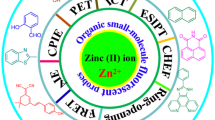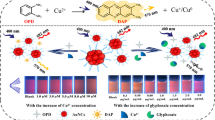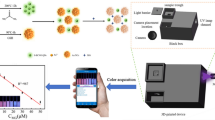Abstract
Probes for detecting phosphate ions (Pi) are required for environmental monitoring and to protect human health. Here, novel ratiometric luminescent lanthanide coordination polymer nanoparticles (CPNs) were successfully prepared and used to selectively and sensitively detect Pi. The nanoparticles were prepared from adenosine monophosphate (AMP) and Tb3+, and lysine (Lys) was used as a sensitizer (through the antenna effect) to switch on Tb3+ luminescence at 488 and 544 nm while Lys luminescence at 375 nm was quenched because of energy transfer from Lys to Tb3+. The complex involved is here labeled AMP-Tb/Lys. Pi destroyed the AMP-Tb/Lys CPNs and therefore decreased the AMP-Tb/Lys luminescence intensity at 544 nm and increased the luminescence intensity at 375 nm at an excitation wavelength of 290 nm, meaning ratiometric luminescence detection was possible. The ratio between the luminescence intensities at 544 and 375 nm (I544/I375) was strongly associated with the Pi concentration between 0.1 and 6.0 μM, and the detection limit was 0.08 μM. The dual-emission reverse-change ratio luminescence sensing method can exclude environmental effects, so the proposed assay was found to be very selective. The method was successfully used to detect Pi in real water samples, and acceptable recoveries were found, suggesting that the method could be used in practice to detect Pi in water samples.





Similar content being viewed by others
References
Zhang X, Wang J, Juan Y, Yang H, Wei W, Zhao J. A novel fluorescence method for detection of phosphate anions based on porphyrin metalation. Spectrochim Acta Part A. 2022;274:121136.
Fan C, Lv X, Tian M, Yu Q, Mao Y, Qiu W, Wang H, Liu G. A terbium(III)-functionalized zinc(II)-organic framework for fluorometric determination of phosphate. Microchim Acta. 2020;187(1):84.
Zhao C-X, Zhang X-P, Shu Y, Wang J-H. Europium–pyridinedicarboxylate–adenine light-up fluorescence nanoprobes for selective detection of phosphate in biological fluids. ACS Appl Mater Interfaces. 2020;12(20):22593–600.
He J, Sun H, Dai J, Wang H, Yu L, Zhou W, Shao Z. In situ growth of nanoflake and nanoflower-like Ni hydrated hydroxide on the surface of Ni foam as a free-standing electrode for high-performance phosphate detection. J Hazard Mater. 2020;392:122313.
Cheng C, Zhang R, Wang J, Zhang Y, **ong S, Huang Y, Yang M. Porphyrinic metal–organic framework nanorod-based dual-modal nanoprobe for sensing and bioimaging of phosphate. ACS Appl Mater Interfaces. 2020;12(23):26391–8.
Qin Y, Li Z, He Y, Wang M, Song G. Boron carbon oxynitride quantum dots-based ratio fluorescent nanoprobe assisted with smartphone for visualization detection of phosphate. Microchim Acta. 2022;189(6):238.
Liu J, Bao H, Liu C, Wu F, Gao F. “Turn-on” fluorescence determination of β-glucosidase activity using fluorescent polymer nanoparticles formed from polyethylenimine cross-linked with hydroquinone. ACS Appl Polym Mater. 2019;1(11):3057–63.
Liu J, Bao H, Liu C, Wu F, Fu T. “Turn-on” fluorometric probe for hydroquinone and catechol based on an in situ reaction between protamine sulfate and dihydroxybenzene isomers and the formation of fluorescent polymer nanoparticles. Sens Actuators, B. 2021;333:129565.
Qi F, Han Y, Ye Z, Liu H, Wei L, **ao L. Color-coded single-particle pyrophosphate assay with dark-field optical microscopy. Anal Chem. 2018;90(18):11146–53.
**a M, Zhao X-E, Sun J, Zheng Z, Zhu S. Graphene quantum dots combined with the oxidase-mimicking activity of Ce4+ for ratiometric fluorescent detection of Ce4+ and alendronate sodium. Sens Actuators B. 2020;319:128321.
Jalili R, Khataee A, Rashidi M-R, Luque R. Dual-colored carbon dot encapsulated metal-organic framework for ratiometric detection of glutathione. Sens Actuators B. 2019;297:126775.
Fahimi-Kashani N, Hormozi-Nezhad MR. A smart-phone based ratiometric nanoprobe for label-free detection of methyl parathion. Sens Actuators B. 2020;322:128580.
Rahimi F, Anbia M. Determination of cyanide based on a dual-emission ratiometric nanoprobe using silver sulfide quantum dots and silicon nanoparticles. Microchim Acta. 2022;189(3):115.
Li S, Fu G, Wang Y, **ang Y, Mu S, Xu Y, Liu X, Zhang H. A dual-signal fluorescent probe for detection of acid phosphatase. Anal Bioanal Chem. 2021;413(15):3925–32.
Tian Y, Zhang Z, Gao N, Huang P, Wu FY. A label-free luminescent assay for tyrosinase activity monitoring and inhibitor screening with responsive lanthanide coordination polymer nanoparticles. Spectrochim Acta Part A. 2020;228:117751.
Yegorova A, Skrypynets Y, Leonenko I, Duerkop A. New terbium complex as a luminescent probe for determination of chlorogenic acid in green coffee and roasted coffee infusions. Anal Bioanal Chem. 2023;415:235–44.
Chen L, Liu D, Zheng L, Yi S, He H. A structure-dependent ratiometric fluorescence sensor based on metal-organic framework for detection of 2,6-pyridinedicarboxylic acid. Anal Bioanal Chem. 2021;413(16):4227–36.
Li Z, Liu G, Fan C, Pu S. Ratiometric fluorescence for sensitive detection of phosphate species based on mixed lanthanide metal organic framework. Anal Bioanal Chem. 2021;413(12):3281–90.
Zhang Z, Wang L, Li G, Ye B. Lanthanide coordination polymer nanoparticles as a turn-on fluorescence sensing platform for simultaneous detection of histidine and cysteine. Analyst. 2017;142(10):1821–6.
Schäferling M, Wolfbeis OS. Europium tetracycline as a luminescent probe for nucleoside phosphates and its application to the determination of kinase activity. Chem - Eur J. 2007;13(15):4342–9.
Tan H, Ma C, Chen L, Xu F, Chen S, Wang L. Nanoscaled lanthanide/nucleotide coordination polymer for detection of an anthrax biomarker. Sens Actuators B. 2014;190:621–6.
Huang P, Wu F, Mao L. Target-triggered switching on and off the luminescence of lanthanide coordination polymer nanoparticles for selective and sensitive sensing of copper ions in rat brain. Anal Chem. 2015;87(13):6834–41.
Wang H, Fu T, Ai M, Liu J. Ratiometric fluorescence nanoprobe based on carbon dots and terephthalic acid for determining Fe2+ in environmental samples. Anal Bioanal Chem. 2022;414(23):6735–41.
Zhang Y, Sheng S, Mao S, Wu X, Li Z, Tao W, Jenkinson IR. Highly sensitive and selective fluorescent detection of phosphate in water environment by a functionalized coordination polymer. Water Res. 2019;163:114883.
Asha KS, Bhattacharjee R, Mandal S. Complete transmetalation in a metal-organic framework by metal ion metathesis in a single crystal for selective sensing of phosphate ions in aqueous media. Angew Chem Int Ed. 2016;55(38):11528–32.
Zhang Z, Tao H, Cao Q, Li L, Xu S, Li Y, Liu Y. Ratiometric fluorescence sensor for sensitive detection of inorganic phosphate in environmental samples. Anal Bioanal Chem. 2022;414(11):3507–15.
Dhar S, Sen B, Mukhopadhyay SK, Mukherjee T, Chattopadhyay AP, Pramanik S. CdS quantum dots embedded in PVP: Inorganic phosphate ion sensing in real sample and its antimicrobial activity. Spectrochim Acta Part A. 2020;234:118256.
Han L, Liu SG, Yang YZ, Fan YZ, Zhou J, Zhang XY, Li NB, Luo HQ. A lanthanide coordination polymer as a ratiometric fluorescent probe for rapid and visual sensing of phosphate based on the target-triggered competitive effect. J Mater Chem C. 2020;8(37):13063–71.
Wu Z, Yang H, Pan S, Liu H, Hu X. Fluorescence-scattering dual-signal response of carbon dots@ZIF-90 for phosphate ratiometric detection. ACS Sens. 2020;5(7):2211–20.
Yang L, Zhang Q, Han Y, Li H, Sun S, Xu Y. The selective deprotonation of carbon quantum dots for fluorescence detection of phosphate and visualization of latent fingerprints. Nanoscale. 2021;13(30):13057–64.
Zhang J, Bian Y, Liu D, Zhu Z, Shao Y, Li M. Detection of phosphate in human blood based on a catalytic hydrogen wave at a molybdenum phosphide modified electrode. Anal Chem. 2019;91(22):14666–71.
Acknowledgements
This work was supported by the Natural Science Foundation of Anhui Province, China (1708085MB48).
Author information
Authors and Affiliations
Corresponding author
Ethics declarations
Competing interests
The authors declare no competing interests.
Additional information
Publisher's note
Springer Nature remains neutral with regard to jurisdictional claims in published maps and institutional affiliations.
Supplementary Information
Below is the link to the electronic supplementary material.
Rights and permissions
Springer Nature or its licensor (e.g. a society or other partner) holds exclusive rights to this article under a publishing agreement with the author(s) or other rightsholder(s); author self-archiving of the accepted manuscript version of this article is solely governed by the terms of such publishing agreement and applicable law.
About this article
Cite this article
Wang, H., Ai, M. & Liu, J. Detecting phosphate using lysine-sensitized terbium coordination polymer nanoparticles as ratiometric luminescence probes. Anal Bioanal Chem 415, 2185–2191 (2023). https://doi.org/10.1007/s00216-023-04624-8
Received:
Revised:
Accepted:
Published:
Issue Date:
DOI: https://doi.org/10.1007/s00216-023-04624-8




